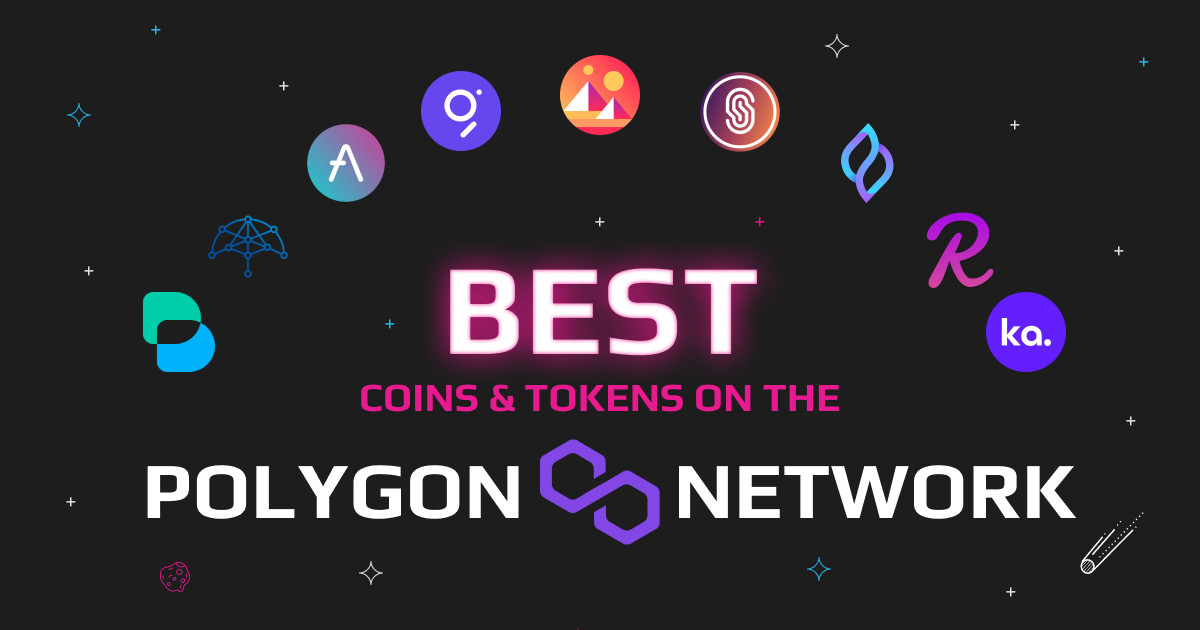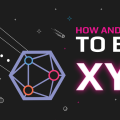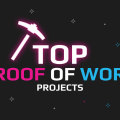From DAOs to synthetic assets, the Polygon network is full of projects trying to change the way we interact with the decentralized web. Let’s take a look at what Polygon is all about and some of the most popular projects on Polygon right now.
What is Polygon?
Polygon is a decentralized ecosystem of protocols that enables Ethereum to be scaled to thousands of transactions per second. Polygon also provides a wide range of tools and services for developers to easily build and deploy decentralized applications on Ethereum. Polygon’s native token, MATIC, is used to pay transaction fees on the network. Polygon launched in March 2021, bringing together the former Matic Network and Ethereum sidechain. The project has since been renamed Polygon.

There are some Ethereum-scaling solutions on Polygon. Some of which include:
- Polygon PoS: Polygon PoS is a layer 2 scaling solution that uses side-chains for transaction processing to achieve exceptional transaction speed and cost reductions. Likewise, POS protects assets via a decentralized network of Proof-of-Stake (PoS) validators and the powerful Plasma bridging framework. Polygon’s scalable proof-of-stake design compliments Ethereum’s decentralized security, allowing you to build applications that appeal to a broad audience while keeping decentralization’s potency.
- Polygon Hermez: The Hermez zk-rollup is a layer 2 architecture built on top of Ethereum that overcomes scalability issues by combining several transactions into a single transaction. To show and publicly record the authenticity and accuracy of the rolled transactions executed on the Ethereum blockchain, the “zero-knowledge proof” (ZK) technology is utilized.
- Polygon Edge: Polygon Edge allows you to create your blockchain network with a variety of features that you may customize. It is based on modular design concepts and enables Ethereum compatibility with your network.
- Polygon Nightfall: Polygon Nightfall is an Optimistic Rollup designed to make private transferring of ERC20, ERC721, and ERC1155 tokens more affordable. It employs an Optimistic Rollup to lower transaction costs and zero-knowledge proofs to ensure anonymity.
Some are still under development, like:
- Polygon Avail: Avail allows for modular chain design, with data ordering and availability handled by Avail in a variety of execution environments.
- Polygon Miden: Polygon Miden is an Ethereum layer 2 scaling solution. Miden uses zero-knowledge technology (zk-STARKs) to “roll-up” thousands of layer 2 transactions into a single Ethereum transaction, leading to increased throughput and lower transaction fees.
- Polygon Zero: Polygon Zero is an Ethereum layer 2 scaling solution. Plonky2, the ground-breaking prover system, which creates ZK proofs quicker than any other existing tech, is what sets Polygon Zero apart from other ZK scaling solutions.

Bella Protocol (BEL)
Bella Protocol is a platform that offers some DeFi solutions aimed at making crypto banking more accessible and straightforward. Co-founded in 2020 by Felix Xu and Yemu Xu, the protocol promises to improve the user experience by removing the high fees and delayed transaction problems that certain blockchain platforms might have, while also streamlining the process with its DeFi smart portal.
The BEL token is an important feature of the Bella Protocol ecosystem, as it functions as both a reward token and a voting token in the platform’s governance. BEL may be used to receive staking rewards, farm network fee rewards, and gain unique discounts on Bella protocol items.
In July 2021, Bella Protocol announced a partnership with Dinoswap (a cross-chain infrastructure platform that helps layer-one blockchains, AMMs, and partnered initiatives develop liquidity) which meant the BEL token migrated to the Polygon ecosystem. Bella can overcome the high fees, slow speeds, and poor UX of DeFi protocols on the Ethereum mainchain by switching to MATIC (the Ethereum token that powers the Polygon network), resulting in a full DeFi experience that is unmatched.

MANA
The MANA token is the native currency of the Decentraland platform. It is used to purchase land, goods, and services within the Decentraland virtual world. It is also used to pay for transaction fees on the Decentraland blockchain. Decentraland is a virtual world where users can buy, sell, or lease land. The land is stored on the Ethereum blockchain and each parcel of land is represented by a non-fungible token (NFT). Decentraland, co-founded by Ariel Meilich and Esteban Ordano, is a platform built for content creators, businesses, and individuals seeking a new artistic medium, business opportunity, or source of entertainment.
In April 2021, Decentraland announced a token bridge that would allow Decentraland’s dApps to conduct fee-free transactions on the Polygon network. The integration enables Decentraland to extend its services and give developers and users of the platform the speed, affordability, and usability needed to do basic, daily tasks.
Users may claim, buy, sell, and trade wearables fully through the Polygon platform. Through integration with crypto on/off ramp Transak, the platform also allows users to purchase MANA tokens directly with debit and credit cards on Polygon.

REEF
The REEF token is the native currency of REEF-chain, and it is utilized for liquidity, transaction fees, and governance. REEF (which stands for Reliable, Extensible, Efficient and Fast) chain is a DeFi, NFTs, and gaming-friendly layer 1 and EVM compatible blockchain. It’s fast, scalable, has minimal transaction costs, and doesn’t mine inefficiently. It is built with the Substrate Framework and has on-chain governance. It employs a consensus algorithm called Nominated Proof of Stake.
The Reef chain can run any DeFi protocol that has already been implemented on Ethereum or an EVM-compatible network with only a few code modifications. Reef ecosystem may be accessed by anybody with a Web3 wallet who is interested in accessing dApps on Reef since Reef Chain straddles this crossroads between Ethereum and Polkadot, as well as bridges to other blockchains.

GRT
The Graph is an indexing protocol that can be used to query networks such as Ethereum and IPFS. Anyone can create and publish open APIs, known as subgraphs, that make data more accessible. Participants use Graph Token (GRT) to assure the economic security of The Graph Network as well as the integrity of the data being queried. GRT is a work token that Indexers, Curators, and Delegators use to supply the network with indexing and curating services.
The Graph expanded its use case on Polygon with the launch of its billing contract for Subgraph Studio on Polygon (Developers can use Subgraph Studio to build, test, and deploy subgraphs, as well as manage their API keys).

AAVE
Aave is a DeFi lending protocol. It’s a non-custodial, open-source money market platform that allows you to earn interest on deposits and borrow a variety of digital assets. AAVE functions as a governance token, providing owners a voice in the protocol’s future development. It also rewards holders with discounted platform fees.
In 2021, Aave announced integration with Polygon. Polygon’s launch of an Aave market was important in kicking off the DeFi ecosystem and providing a stable source of liquidity for its customers. The implementation aims to create alternatives for DeFi apps that may be used by anybody, allowing users to take advantage of “nearly-free” transactions.

UMB
Umbrella network is the world’s first genuinely decentralized oracle, offering low-cost, massively scalable, and secure smart contract solutions. They give blockchain developers access to data that was previously unavailable to them and at a much lower cost than any other oracle in the business. The Umbrella Network’s decentralized power is based on the UMB utility token, which is used for staking, community voting, as well as rewards and incentives.
Since the launch of Umbrella Network on Polygon, a slew of dApps on the Polygon ecosystem have been able to integrate Umbrella Network’s data feeds directly into their smart contracts.

SFUND
Seedify is an Incubator and Launchpad for Blockchain Gaming. By staking $SFUND, you can purchase game tokens before the rest of the community, giving you an advantage in the play-to-earn era.
Its ecosystem also comprises Seedify NFT Space, the industry’s first gaming-and-metaverse-asset-centric NFT marketplace, as well as an NFT launchpad for gaming and metaverse assets.
They can give top-tier blockchain solutions, funding options, development support, and the capacity to produce games with excellent user experiences while optimizing ROI for project investors because of their integration with Polygon.

SHFT
The Shyft Network is a public protocol that checks for identity and power compliance in blockchain data. Shyft Network provides valuable user information that institutions may use to safeguard cryptocurrency while maintaining privacy by allowing the transfer of verifiable data across centralized and decentralized ecosystems. The Shyft protocol is powered by SHFT, a native token. The token serves as a payment method, a mechanism for linking value, and a tool for capturing value. The currency is used for data transfer and identification, and it also acts as a governance tool for ecosystem coordination.
Shyft Network and Polygon have teamed up to provide an opt-in compliance infrastructure for decentralized finance (DeFi). Developers can integrate Shyft Network core contracts into their Dapps to enable Know-Your-Customer (KYC) and identity primitives, compliant asset pools, routed reputation and verification across Dapps, and comply with incoming Decentralized Finance and custodial and non-custodial FATF global guidance requirements, as well as comply with incoming Decentralized Finance and custodial and non-custodial FATF global guidance requirements.

KASTA
Within the Kasta ecosystem, KASTA is a cryptocurrency token with a wide range of applications and benefits. KASTA can be bought and sold just like another cryptocurrency. KASTA will play a critical part in Kasta’s growth and in realizing its aim of guiding the globe toward widespread cryptocurrency adoption.
Late last year, Kasta announced they have chosen Polygon to be the network in which they build their new era of decentralized open and borderless payments. The choice was based on the fact that Polygon network’s scaling solutions, lower fees, faster transaction throughput, and approach to decentralization.
Top Polygon Projects- Conclusion
Polygon network is becoming more relevant by the day due to its impressive scalability. It’s hardly surprising that several projects like Bella Protocol, Kasta, Aave, Decentraland, Shyft network amongst others are leveraging the versatility of Polygon network.
Interestingly, many of these promising projects have tokens that can be exchanged on Swapzone.
Swapzone is an instant exchange that offers increased liquidity, zero incidence of getting hacked, and transactions at the lowest fees possible.


